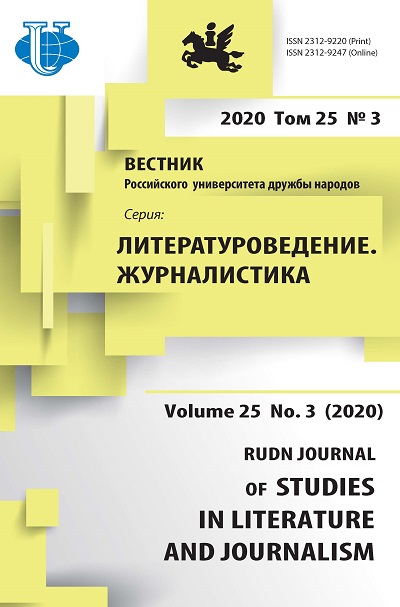Opportunities and risks in the process of socialization of modern adolescents in the medium of new media
- Authors: Jin H.1
-
Affiliations:
- Lomonosov Moscow State University
- Issue: Vol 25, No 3 (2020)
- Pages: 576-585
- Section: JOURNALISM
- URL: https://journals.rudn.ru/literary-criticism/article/view/24833
- DOI: https://doi.org/10.22363/2312-9220-2020-25-3-576-585
- ID: 24833
Cite item
Full Text
Abstract
The article presents the results of several studies that demonstrate the impact of new (digital) media on the socialization of adolescents. This article aims to show the problem of studying opportunities and risks in the process of communication of the younger generation in the online space. Researchers whose works are highlighted in this article pointed out the positive impact of new media, as well as pay attention to the following risks that teenagers face on the Web: negative information, cyberbullying, addiction from smartphones and laptops, Internet fraud, and personal data leakage. These and other factors induce the transformation of the psychological state of adolescents, change their consciousness, and correct behavior. To mitigate and eliminate the negative impact of digital media on adolescents, the author proposes to discuss preventive measures systemically, in the “government - society - media platform” paradigm, noting that the self-regulation of platforms is an essential tool for non-state influence on the situation. The author also notes the need for the formation of media literacy among teenagers and parents.
Keywords
About the authors
Han Jin
Lomonosov Moscow State University
Author for correspondence.
Email: jin.han2017@yandex.ru
PhD student of the Department of New Media and Communication Theory of the Faculty of Journalism
9 Mokhovaya St, bldg 1, Moscow, 125009, Russian FederationReferences
- Russian Public Opinion Research Center (VTsIOM). (2019, March 6). Podrostok v social'noj seti: Norma zhizni – ili signal opasnosti? [A teenager on a social network: A norm of life – or a signal of danger?]. Dannye oprosov [Survey data]. No. 3898. Retrieved May 30, 2020. from https://wciom.ru/index.php?id=236&uid=9587
- Yarygina, I.I. (2017). Vliyanie interneta na process socializacii podrostkov [The influence of the Internet on the process of socialization of adolescents]. Gaudeamus, 17(37), 57−62.
- Anderson, M., & Jiang, J. (2018, November 11). Teens’ Social Media Habits and Experiences. Retrieved March 2, 2020, from https://www.pewinternet.org/2018/11/28/ teens-social-media-habits-and-experiences/
- Chvanova, M.S., Anureva, M.S., & Kiseleva, I.A. (2017). Vliyanie Interneta na socializaciyu molodezhi [The influence of the Internet on the socialization of youth]. Tambov University Review. Series: Humanities, 22(5(169)), 23−36.
- Fletcher, J., & Nicholas, K. (2016). Reading for 11–13-year-old students in the digital age: New Zealand case studies. Education, 46(1), 37−48.
- Ni Syao, L., & Shao Syao, J. (2019). Influence of youth use of social networks on the Internet on subjective well-being: A consistent intermediate path of self-esteem and self-identification. Bulletin of Lanzhou University, (1), 122−133. (In Chinese.)
- Riesmeyer, C., Hauswald, J., & Mergen, M. (2019). (Un)Healthy Behavior? The Relationship between Media Literacy, Nutritional Behavior, and Self-Representation on Instagram. Media and Communication, 7(2), 160−168.
- Sobkin, V.S., & Fedotova, A.V. (2019). Podrostkovaya agressiya v social'nyh setyah: Vospriyatie i lichnyj opyt [Adolescent aggression in social networks: Perception and personal experience]. Psihologicheskaya nauka i obrazovanie [Psychological science and education], 24(2), 5−18.
- Cyberbullying Research Center report, 2010. (n.d.). Retrieved March 6, 2020, from http://www.cyberbullying.us/
- Bychkova, A.M., & Radnaeva, E.L. (2018). Dovedenie do samoubijstva posredstvom ispol'zovaniya internet-tekhnologij: Social'no-psihologicheskie, kriminologicheskie i ugolovno-pravovye aspekty [Driving to suicide through the use of Internet technologies: Socio-psychological, criminological and criminal-legal aspects]. Vserossisjkij kriminologicheskij zhurnal [All-Russian journal of criminology], 12(1), 101–115.
- Volkova, I., Kadyrova, S., Rastorgueva, N., & Algavi, L. (2017). From the Silent House Meme to the Blue Whale-Game: The Storyworld’s Transformation. International Multidisciplinary Scientific Conference on Social Sciences & Arts SGEM (pp. 253–260). doi: 10.5593/sgemsocial2017/41/S16.032.
- “Sinij kit”: Pochemu uzhestochenie zakona ne ostanavlivaet “gruppy smerti” [“Blue Whale”: Why Tightening the Law Doesn't Stop “Death Groups”]. Retrieved May 25, 2020, from https://ria.ru/20200620/1573186152.html
- Syao Yuj, B., & Guj, M. (2019). Analysis of the behavior of abandoned children who are addicted to mobile games from the point of view of demand theory. Journal of Xingtai University, (3), 186−189. (In Chinese.)
- Cyum, Cgen'huej. (2018). Poll: 20% of Chinese teens are at risk of online gaming addiction. Retrieved March 9, 2020, from http://www.chinanews.com/sh/2018/07-02/ 8553248.shtml. (In Chinese.)
- Tyan, F., Go, Zh., Huan Yun, L., & Chzhu, T. (2018). Research on the safety of Chinese adolescents on the Internet]. The study of public security, (4), 1−10. (In Chinese.)
- Children’s Online Privacy Protection Act (15 U.S.C. §§ 6501–6506). (n.d.). Retrieved March 9, 2020, from https://www.ftc.gov/enforcement/statutes/childrens-online-privacy-protection-act
- Chou, H.L., & Chou, C. (2019). A quantitative analysis of factors related to Taiwan teenagers’ smartphone addiction tendency using a random sample of parent-child dyads. Computers in Human Behavior, 99, 335−344.
- Ahmad Zukarnain, Z., Hashim, M.Z., Muhammad, N., Mansor, F.A., & Wan Azib, W.N.H. (2020). Impact of training on cybersecurity awareness. GADING Journal of Science and Technology, 3(1), 114−120.
Supplementary files















